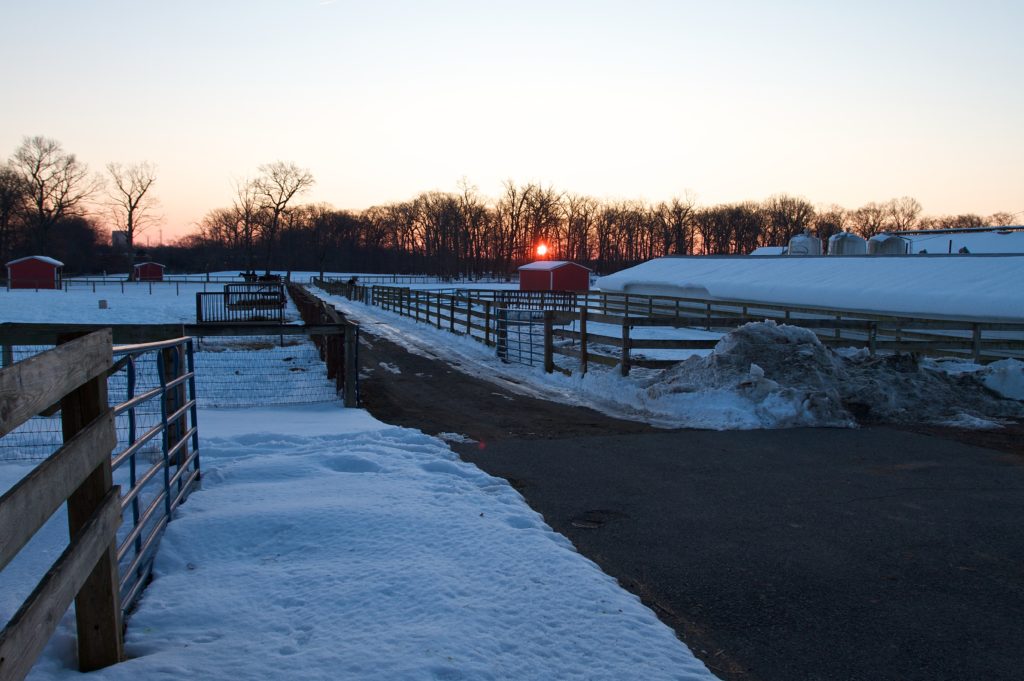Hay Everyone!
Happy new year! Winter has definitely arrived. My pasture is sadly lacking in grass and snow has become commonplace. As we all know, winter brings an added layer of difficulty to your daily horse care chores. Wading through all the mud and snow just to take a look at your horse and make sure it has plenty of feed and water can be exhausting. Even though winter may not be your favorite time of year, your horse can remain happy and healthy with a little bit of help from you! I’ve asked the folks here at the Equine Science Center to help me compile a winter horse care checklist. See how you measure up on your winter horse care practices!
First and foremost, you want to make sure your horse always has plenty of food. (I think this is always the most important part of horse care!). The winter season can increase your horse’s nutrient requirements. Horses, humans, and other animals expend energy to stay warm once the temperature falls below a point known as the lower critical temperature sometimes abbreviated LCT. In horses, the lower critical temperature ranges from 5°F to 41°F depending on where the horse lives and whether it has been clipped. This lower critical temperature is lower in horses than it is in humans which means your horse is still comfortable at temperatures where you might start to feel cold. This extra work to stay warm means your horse is expending extra energy and may lose weight if you don’t increase its feed. Not only does the amount of feed matter, but the type of feed is also important. Forage will provide more heat for your horse than feeding concentrates. Horses ferment fiber in the cecum which produces large amounts of heat and helps your horse stay warm during these cold winter months! For more information, check out the fact sheet on Winter Feeding for Horses.
It is especially important to monitor your horse’s body condition and/or weight during the winter months. Decreases in body condition or weight indicate your feeding changes are not adequate and you may need to provide more hay or concentrate for you horse. Monitoring your horse’s body condition in the winter will require a hands-on inspection as a woolly winter coat and blanket can hide changes. You don’t want to get to spring and realize your horse has lost a bunch of weight. (I make sure the folks here at the Center keep close tabs on my weight. At the slightest sign of weight loss, I make sure they increase my ration!) Inspecting your horse on a regular basis will also ensure you don’t miss any bumps or scrapes it might have picked up while out playing in the snow. A long, winter hair coat can easily hide a small scrape.

Water is just as important as feed in keeping your horse healthy this winter season. Inadequate water intake can lead to dehydration and health problems. Colic can be a common problem in the winter, especially if the weather changes suddenly. Keeping clean, fresh water available at all times will encourage your horse to drink and stay hydrated. You’ll want to make sure you break and remove ice on water troughs and buckets at least daily. Removing ice more often will make it more likely your horse is drinking enough water. Another option is to install heaters in your water troughs and buckets. If you decide to go this route, you’ll want to make sure you follow the manufacturer’s directions. Inspect the unit for wear and use a safe source of power. You don’t want to end up shocking your horse. This will definitely discourage it from drinking! My whiskers tingle just thinking about it.
Another common concern among horse owners is whether to blanket their horses or bring them inside. Remember our discussion about the lower critical temperature in horses? Well, as we noted, horses are comfortable and happy in much colder temperatures than people are. This means your horse is perfectly happy outside even when you may find it a bit on the chilly side. In most conditions, horses are fine outside, although providing a wind break of some sort like a run-in shed or line of trees can make them more comfortable by providing a place to get out of the wind. Cold temperatures combined with rain are generally the most unpleasant conditions for your horse. The rain can chill your horse and prevent their fur from providing its normal protective layer. A horse’s thick winter hair coat also serves to trap a layer of air next to the horse’s skin which helps to keep it warm. Again, shelter such as a run-in shed can provide all the protection your horse needs against the elements. If you do choose to blanket your horse, make sure it doesn’t overheat on a warmer day. For tips on blanketing, you can take a look at a the Blanketing Fact Sheet. You’ll also need to remove the blanket on a regular basis to check for rubs and assess your horse’s body condition underneath the blanket.
Hopefully, these tips will make your winter horse care a breeze this year! For more details, you can also check out our Winter Horse Care Fact Sheet. With a little bit of effort and diligence on your part, your horse will be happy and healthy all year round. I’m off to grab a few more bites of hay. I don’t want to lose any weight during these cold days!
Until next time!
Your Friend,

Lord Nelson
